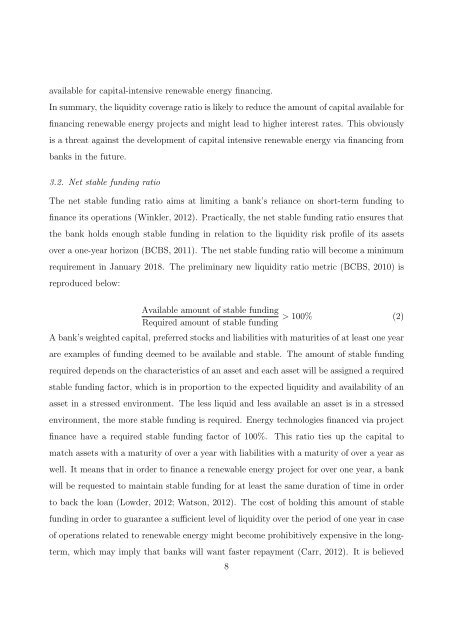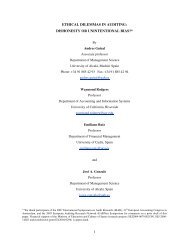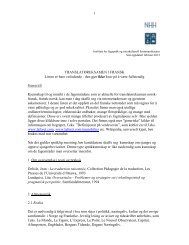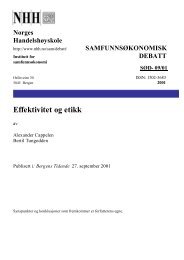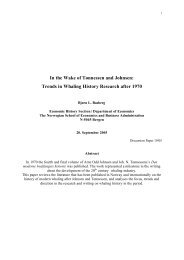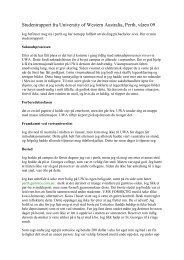The likely impact of Basel III on a bank's appetite for ... - NHH
The likely impact of Basel III on a bank's appetite for ... - NHH
The likely impact of Basel III on a bank's appetite for ... - NHH
You also want an ePaper? Increase the reach of your titles
YUMPU automatically turns print PDFs into web optimized ePapers that Google loves.
available <strong>for</strong> capital-intensive renewable energy financing.In summary, the liquidity coverage ratio is <str<strong>on</strong>g>likely</str<strong>on</strong>g> to reduce the amount <str<strong>on</strong>g>of</str<strong>on</strong>g> capital available <strong>for</strong>financing renewable energy projects and might lead to higher interest rates. This obviouslyis a threat against the development <str<strong>on</strong>g>of</str<strong>on</strong>g> capital intensive renewable energy via financing frombanks in the future.3.2. Net stable funding ratio<str<strong>on</strong>g>The</str<strong>on</strong>g> net stable funding ratio aims at limiting a bank’s reliance <strong>on</strong> short-term funding t<str<strong>on</strong>g>of</str<strong>on</strong>g>inance its operati<strong>on</strong>s (Winkler, 2012). Practically, the net stable funding ratio ensures thatthe bank holds enough stable funding in relati<strong>on</strong> to the liquidity risk pr<str<strong>on</strong>g>of</str<strong>on</strong>g>ile <str<strong>on</strong>g>of</str<strong>on</strong>g> its assetsover a <strong>on</strong>e-year horiz<strong>on</strong> (BCBS, 2011). <str<strong>on</strong>g>The</str<strong>on</strong>g> net stable funding ratio will become a minimumrequirement in January 2018. <str<strong>on</strong>g>The</str<strong>on</strong>g> preliminary new liquidity ratio metric (BCBS, 2010) isreproduced below:Available amount <str<strong>on</strong>g>of</str<strong>on</strong>g> stable fundingRequired amount <str<strong>on</strong>g>of</str<strong>on</strong>g> stable funding> 100% (2)A bank’s weighted capital, preferred stocks and liabilities with maturities <str<strong>on</strong>g>of</str<strong>on</strong>g> at least <strong>on</strong>e yearare examples <str<strong>on</strong>g>of</str<strong>on</strong>g> funding deemed to be available and stable. <str<strong>on</strong>g>The</str<strong>on</strong>g> amount <str<strong>on</strong>g>of</str<strong>on</strong>g> stable fundingrequired depends <strong>on</strong> the characteristics <str<strong>on</strong>g>of</str<strong>on</strong>g> an asset and each asset will be assigned a requiredstable funding factor, which is in proporti<strong>on</strong> to the expected liquidity and availability <str<strong>on</strong>g>of</str<strong>on</strong>g> anasset in a stressed envir<strong>on</strong>ment. <str<strong>on</strong>g>The</str<strong>on</strong>g> less liquid and less available an asset is in a stressedenvir<strong>on</strong>ment, the more stable funding is required. Energy technologies financed via projectfinance have a required stable funding factor <str<strong>on</strong>g>of</str<strong>on</strong>g> 100%.This ratio ties up the capital tomatch assets with a maturity <str<strong>on</strong>g>of</str<strong>on</strong>g> over a year with liabilities with a maturity <str<strong>on</strong>g>of</str<strong>on</strong>g> over a year aswell. It means that in order to finance a renewable energy project <strong>for</strong> over <strong>on</strong>e year, a bankwill be requested to maintain stable funding <strong>for</strong> at least the same durati<strong>on</strong> <str<strong>on</strong>g>of</str<strong>on</strong>g> time in orderto back the loan (Lowder, 2012; Wats<strong>on</strong>, 2012). <str<strong>on</strong>g>The</str<strong>on</strong>g> cost <str<strong>on</strong>g>of</str<strong>on</strong>g> holding this amount <str<strong>on</strong>g>of</str<strong>on</strong>g> stablefunding in order to guarantee a sufficient level <str<strong>on</strong>g>of</str<strong>on</strong>g> liquidity over the period <str<strong>on</strong>g>of</str<strong>on</strong>g> <strong>on</strong>e year in case<str<strong>on</strong>g>of</str<strong>on</strong>g> operati<strong>on</strong>s related to renewable energy might become prohibitively expensive in the l<strong>on</strong>gterm,which may imply that banks will want faster repayment (Carr, 2012). It is believed8


